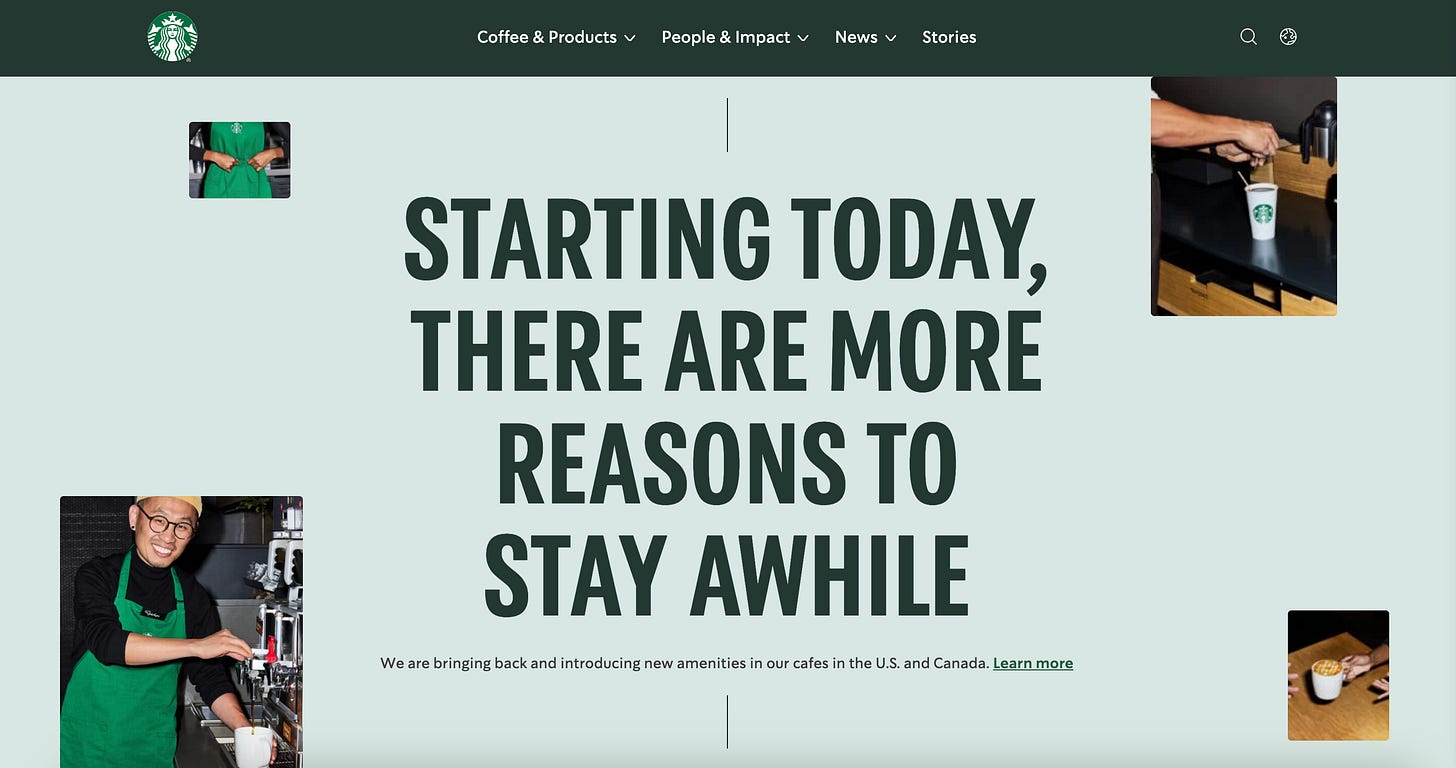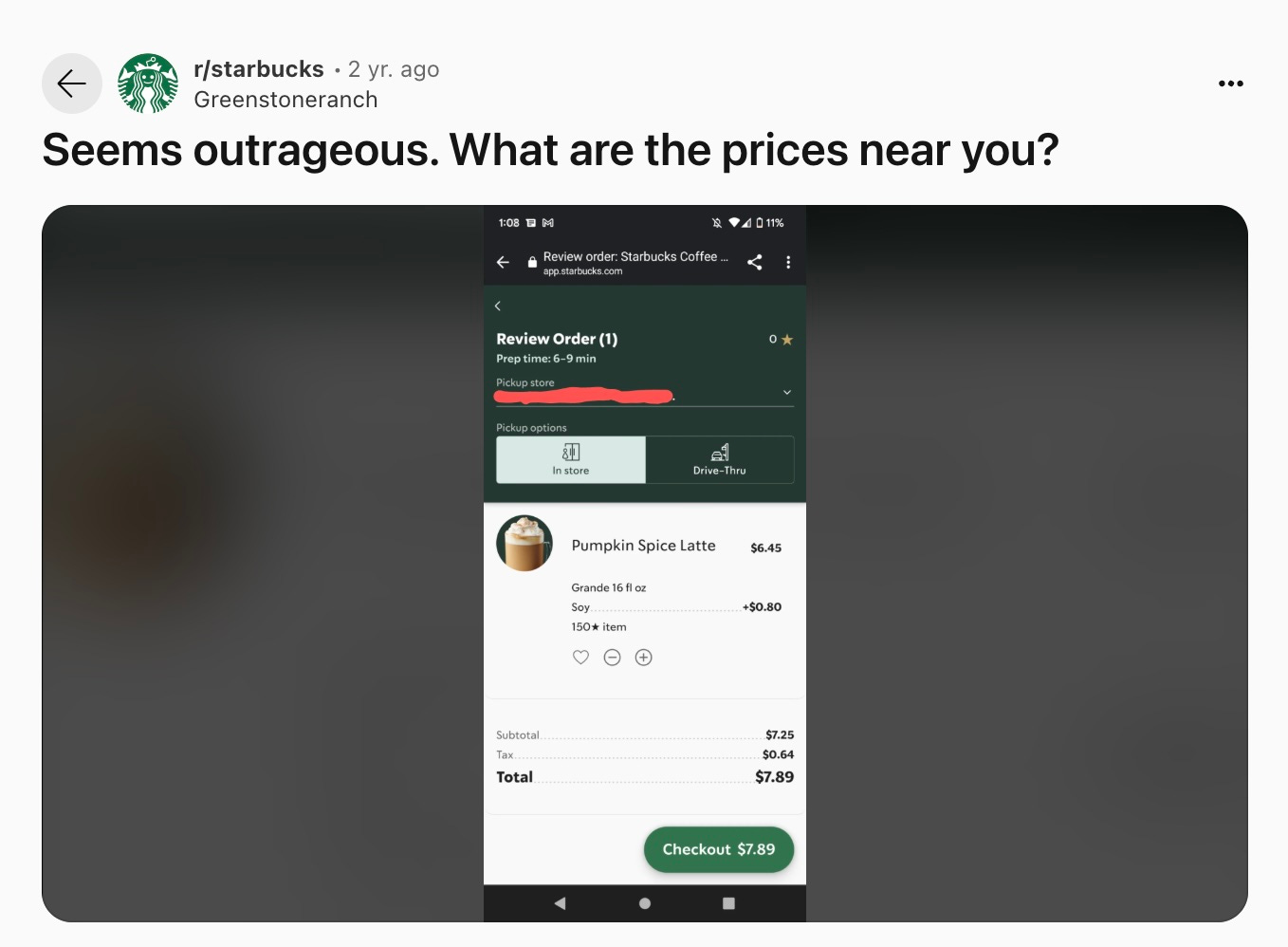☕️ How Starbucks Plans to Return to its Coffeehouse Roots with Free Coffee, a Brand-Led Strategy, and a Superbowl Adjacent campaign 📈
What happened to Starbucks and what does it mean to go 'Back to Starbucks'?
The world’s largest coffee chain is trying to get back to its coffeehouse roots by slashing discounting, investing in brand and improving operational efficiency. Now serving: a front row seat to the case for building a brand from the inside out.
👋 Hi, I'm Amanda. I'm a brand strategist and fractional CMO. I help founder-led businesses turn belief into brand—and brand into a strategic asset that works as hard as you do. I share weekly deep dives with actionable advice on brand building—plus interviews with the people in the trenches. I also work 1:1 with founders and teams. Book a chat here.
Who Will Love This
SBUXX shareholders
Coffee lovers who miss the original Starbucks vibe
Brand strategists watching a global company pivot
Employees of large organizations looking for leadership lessons
Today
G’day.
Today’s newsletter is dedicated to Starbucks: one of the Pacific Northwest’s biggest brands and one that is betting on Superbowl buzz to make its new brand campaign a win.
Despite some serious missteps in recent years, Starbucks on a mission to reclaim its coffeehouse roots.
Starbucks has been facing a major identity crisis.—three CEOs in as many years, messy digital ordering, plummeting sales in China, and a series of public relations misfires. In August Brian Niccol was appointed Starbucks’ new ceo & chairman, bringing in turnaround experience from Taco Bell and Chipotle—and some seriously high pay expectations, already being awarded $96M in his first few months on the job.
Now, six months in, under the company’s first global chief brand officer Tressie Lieberman, Starbucks is reintroducing itself to the world with a back-to-basics strategy. It’s not just about new ads (hat tip to the smart, creative cookies at Anomaly)—it’s about rebuilding the brand from the inside out.
I’m excited to share today’s newsletter because it’s a front row seat to a brand led growth strategy - and case study on the risks of letting a brand languish.
Business Strategy
From coffeehouse origins to crisis management
Starbucks began as a small coffee shop in Pike Place Market, Seattle, in 1971. Fast forward 50+ years, and it’s the world’s largest coffee chain. But after decades of growth, this FastCompany headline says it all:
2024 wasn’t kind to the company—Starbucks kicked off the year by shutting down its NFT marketplace (??? if you’re as baffled by the fact that they started one, same, girl), and ended it with a five-day barista strike, shutting down 170 locations over the Christmas holidays. TLDR, the brand was focused more on products and discounts than its brand.
Cycles of boom, bust and yet another ceo
Starbucks has seen cycles of expansion, contraction, innovation, and retreat, all under a revolving door of CEOs, including Howard Schultz’s three (!) separate tenures.
1990: Under Schultz, Starbucks’ first mission statement is introduced: “Establish Starbucks as the premier purveyor of the finest coffee in the world while maintaining our uncompromising principles as we grow.”
2008: The mission statement expands: “With every cup, with every conversation, with every community, we nurture the limitless possibilities of human connection.”
2022: Schultz’s third stint, studded with with inflation, labor law violations, burnt-out employees, unionization, and increasing pressure for companies to take positions on social issues. In particular, his anti-union efforts and flip-flopping on social issues like Black Lives Matter—damaged his reputation and Starbucks’ credibility.
2023: Laxman Narasimhan takes over as ceo.
2024: August, Brian Niccol, known for his turnaround expertise at QSR (industry speak for Quick Service Restaurants) is appointed ceo & chairman, with a clear directive: transform Starbucks back to its coffeehouse roots.
Starbucks’ Q1 earnings call and letter to partners signaled four initiatives underpinning the strategy:
Over the past four months, we've been focused on getting Back to Starbucks and those things that have always set us apart: a welcoming coffeehouse where people gather and where we serve the finest coffee handcrafted by our skilled baristas. - Brian Niccol, Starbucks Q1 2025 Earnings call
Challenges the Brand Strategy Needs to Address
To execute on this strategy, Starbucks must overcome major hurdles:
1️⃣ Fix the Labor Relations Crisis
Starbucks employs over 200,000 people, and if the workforce isn’t happy, neither are the customers. Following Covid, employees began organizing, and Starbucks mishandled it. The company’s anti-union stance and failure to address worker concerns have become a massive point of contention.
2️⃣ Solve the Digital Dilemma
The Starbucks Rewards app is a powerful tool for customers, but it’s a tool that’s perhaps a little too powerful. Essentially, it’s created a firehose of orders for partners to fulfill.
3️⃣ Refocus on the customer
Starbucks' product offerings are confusingly wide. The Gen Z customer that afford the steep prices are ordering everything except coffee. Starbucks’ menu now features pink drinks, boba, and other non-coffee beverages, but it’s left the brand feeling directionless. Who exactly is Starbucks for in 2025?
4️⃣ Scaling a founders’ vision post Schultz
Starbucks is still very much a founder-led brand, with Howard Schultz casting a long shadow over the company, even though he’s stepped away. Figuring out how to move forward without getting stuck in the past or in arguments about WWHD (What Would Howard Do) will be critical for growth.
5️⃣ Reinvigorating a global brand story
How does Starbucks stay true to a local coffeehouse experience while scaling globally? The story Starbucks tells internally—about community and connection—doesn’t align with its external image, particularly given the controversies surrounding unionization, social issues, and inflation.
Brand Strategy
Niccol’s "Back to Starbucks" strategy is built around four key pillars. Each pillar focuses on rebuilding the brand from the inside out, starting with employees then rolling out to the customer experience:
1️⃣ Focus on Employees: Make Starbucks the Best Place to Work
For Starbucks to deliver the best customer experience, it has to go through its 200,000+ employees (namely the frontline partners, or baristas). Here's how they’re delivering on this pillar:
Increased Benefits: Starbucks has invested in increased tuition coverage and doubled paid parental leave for eligible employees. Not bad.
Internal Promotions: The company has committed to promoting from within for 90% of retail leadership roles over the next three years.
Workplace Improvements: Starbucks has added additional coverage hours across 3,000+ U.S. stores, resulting in improved shift completion and higher employee retention over the past quarter.
 Tiktok failed to load.
Tiktok failed to load.Enable 3rd party cookies or use another browser
2️⃣ Re-establishing Starbucks as the Community Coffeehouse
Starbucks has always prided itself on being a “third place”—a community hub for people to relax, meet, and enjoy their coffee. Under Niccol’s leadership, the brand is re-focusing on delivering a consistent and premium in-store experience:
Focusing on the Coffeehouse Experience: Starbucks has returned to using ceramic mugs, reintroduced handwritten notes on to-go orders, and brought back the condiment bar.
Expanded Free Refills: Starbucks free refill policy includes hot and iced brewed coffee and tea for non-Starbucks Rewards customers at participating stores. Aside from diners, I can’t remember the last place I got a free refill of my coffee. Nice.
Updated Code of Conduct: Starbucks ended the long-standing open-door policy, requiring customers to make a purchase to stay in store, in response to employee concerns over homelessness and store atmosphere.
Improved Pricing Transparency: The company has removed the extra charge for non-dairy milk, addressing frustration about price and pricing transparency. To be fair, this seems like the right approach for a drink that easily approaches $7.
3️⃣ Reintroduce the Brand to the World: Refocus on Starbucks’ Core Identity
Starbucks is re-introducing itself to the world with a strong, clear message that highlights its focus on coffee and the human connection it fosters. Here’s how they’re delivering on this pillar:
Return to Core Identity: Starbucks has re-emphasized its identity as the “Starbucks Coffee Company,” highlighting the company’s roots (and echoing the 1990 mission statement) as a premium cafe. This shift is visible in their latest campaigns—a mega simple yet effective way to boost reinforce Starbucks core offer.
Mission Integration: Starbucks has made its mission statement a central part of its communications and features it prominently in corporate messaging, marketing materials, and on the website.
 Tiktok failed to load.
Tiktok failed to load.Enable 3rd party cookies or use another browser
4️⃣ Get the morning right, every morning
This pillar is one where we see the least immediate change at Starbucks, but I suspect we’ll see a more changes as Niccol transforms the support organization (corporate). Starbucks is targeting a four-minute handoff from barista to customer, and plans changes to the order flow to improve the employee and customer experience.
 Tiktok failed to load.
Tiktok failed to load.Enable 3rd party cookies or use another browser
Brand Marketing Moves 💡
"Back to Starbucks" Campaign: The brand’s new campaign from Anomaly launched with a teaser (“Not My Name”) and followed up with “Hello, Again,” an energetic AC/DC-backed spot that will air following the Superbowl with a call to action to pick up free drip or iced coffee tomorrow. 🏈
Revamped Corporate Messaging to focus on Coffee: Very interesting and telling: the ad and all corporate comms refer to the company as “The Starbucks Coffee Company.” ☕️
Clarified Social Stance: Launched a “For The Record” page to address past social issues, including the withdrawal of lawsuits with Workers United, signaling a commitment to clearer positions on social responsibility. 👈 This is HUGE & I’m dying to know what’s transpired here. Hmu if you have any intel on this.
What we can we learn from Starbucks?
The Power of Creative that Speaks for Itself. Creative is the tactical execution of your brand strategy - think visual identity, scripts, ad treatment. If the brand strategy is the plot of your story, the creative strategy is script that everyone wants to buy. Anomaly’s work for Starbucks is emotive, powerful, true and a major step up for the brand. I’m excited to see this partnership evolve.
Brand Leadership is the Face that Defines the Story. CEOs are the public voice and face of a brand. Niccol is nailing this and understands that what he does is symbolic: he is moving confidently, swiftly, and telling a coherent story about the Starbucks brand. Outgoing CEO Narasimhan’s 6 month immersion as barista when he took over as ceo was widely publicized but failed to culminate in positive changes for employees, customers or shareholders.
How to Control the Narrative. In The West Wing (Season 1, Episode 13, “Take Out the Trash Day”), the White House releases unsavoury news on a Friday, burying it before the weekend. By launching a Superbowl campaign, a free coffee giveaway, and its “Back to Starbucks” plan all at once, while quietly addressing sensitive topics like union issues, layoffs, and policy reversals, Starbucks controls the narrative.
What do you think? Will it work? Stock went up 8% on hearing the news of the back to Starbucks strategy. But I think the real proof will be in the pudding coffee.
That’s all from me today - enjoy the game. 🏈
Questions? Hot takes? Brands you want to see covered? Hit ↩️ reply, or meet me in the comments.












Every ten years this company does a PR push about “refocusing on the coffee” and then spends another decade inventing 24oz pink juices
Interested to see how this goes. I think Starbucks will struggle in small towns and communities that are heavily invested in their local coffee shops (like where I live in Colorado). Another challenge will be creating that cofee house feel at stores that seem so heavily designed for drive through and mobile service